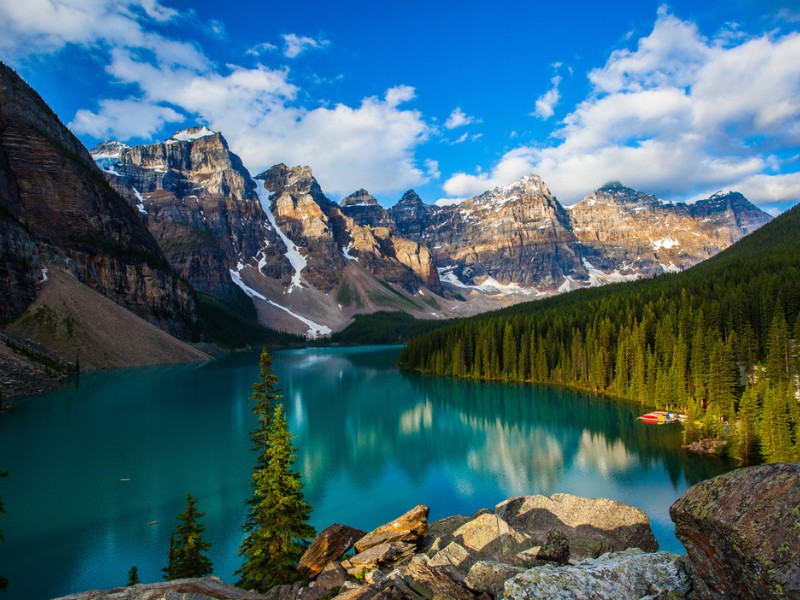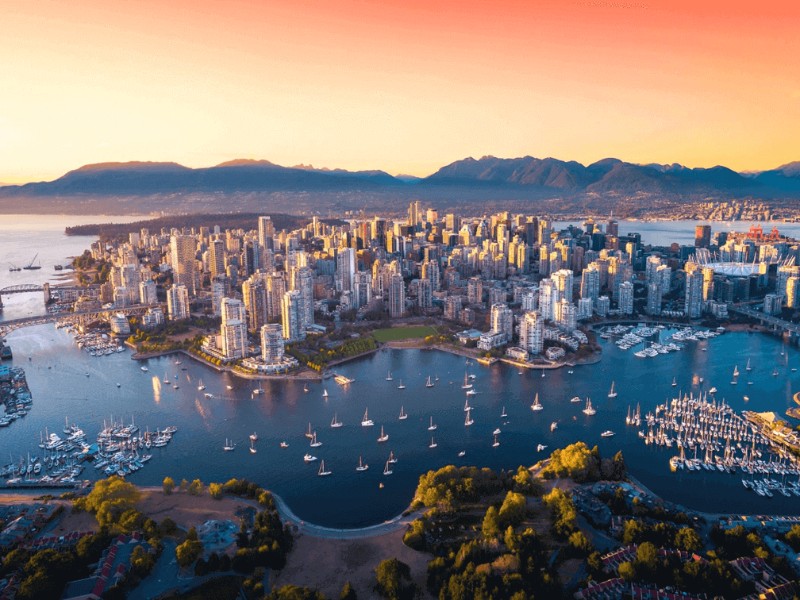
Canada, the second-largest country in the world by land area, is known for its stunning natural beauty, vibrant multicultural cities, and rich history. With vast forests, towering mountains, serene lakes, and bustling urban centers, Canada offers something for every type of traveler. Whether you’re an adventure enthusiast looking to explore the wild outdoors or a culture seeker interested in museums, art, and history, Canada is the perfect destination.
In this travel guide, we’ll take you through the top places to visit, tips on planning your trip, cultural insights, and everything else you need to know to have an unforgettable experience in this beautiful country.
1. Introduction to Canada
Canada is located in North America, bordered by the United States to the south, the Atlantic Ocean to the east, the Pacific Ocean to the west, and the Arctic Ocean to the north. With a land area of over 9.98 million square kilometers, Canada is renowned for its wide-open spaces, majestic landscapes, and a population of just over 38 million people, making it one of the least densely populated countries in the world.
Canada is a multicultural nation, with two official languages—English and French—and a rich cultural heritage influenced by its Indigenous peoples, French and British colonial history, and immigrant communities from around the world.
Canada is home to some of the world’s most famous natural wonders, including Niagara Falls, the Rocky Mountains, and Banff National Park. From cosmopolitan cities like Toronto and Montreal to remote wilderness areas like the Yukon, Canada offers an array of experiences that will captivate any traveler.
2. Planning Your Trip to Canada
Visa and Entry Requirements
Before traveling to Canada, most international travelers will need to apply for a visa or an Electronic Travel Authorization (eTA), depending on their nationality. Travelers from certain countries can apply for an eTA, which is an online application system that allows entry to Canada for short stays (less than six months) for tourism, business, or transit purposes.
It’s essential to apply well in advance and ensure you meet all entry requirements, including proof of funds for your stay and a return ticket. Be sure to check the official website of the Government of Canada for updated information on visa requirements.
Best Time to Visit
Canada is a year-round destination, with each season offering unique experiences. The best time to visit Canada depends on the type of vacation you’re looking for.
- Spring (March to May): Spring is a lovely time to visit Canada, especially in cities like Vancouver and Toronto. The weather is mild, and the cherry blossoms bloom in places like Victoria, British Columbia.
- Summer (June to August): The summer months offer warm weather, making it the perfect time for outdoor activities such as hiking, biking, and sightseeing. Cities like Toronto and Montreal come alive with festivals and events, while the national parks are ideal for exploring nature.
- Fall (September to November): Fall is the best time to visit for beautiful autumn foliage, especially in Quebec and Ontario. The weather is still pleasant, and the crowds from summer have diminished.
- Winter (December to February): Winter is the prime season for skiing and snowboarding, particularly in the Rocky Mountains and Whistler. The winter months also offer festive holiday events in cities like Toronto, Montreal, and Vancouver.
Currency and Payment Methods
The currency in Canada is the Canadian Dollar (CAD). Credit and debit cards are widely accepted across the country, but it’s still advisable to carry some cash for smaller purchases or in rural areas. ATMs are readily available in most cities, and most major international credit cards are accepted.

3. Top Tourist Destinations in Canada
Canada is home to diverse landscapes, from bustling cities to picturesque mountains and serene lakes. Here are the must-visit destinations for any traveler:
Toronto
Toronto, Canada’s largest city, is a vibrant metropolis filled with cultural attractions, art galleries, museums, and shopping districts. The city is home to the iconic CN Tower, one of the tallest freestanding structures in the world, offering panoramic views of the city skyline and Lake Ontario. Other notable attractions include the Royal Ontario Museum, the Art Gallery of Ontario, and the historic Distillery District, which is filled with shops, restaurants, and bars.
For nature lovers, Toronto offers Toronto Islands, a peaceful retreat just a short ferry ride from the downtown core, where you can bike, hike, or relax on the beach.
Vancouver
Vancouver, located on the west coast, is a beautiful city surrounded by stunning natural beauty. The city offers the best of both worlds—urban attractions and outdoor adventures. Visit Stanley Park, one of the largest urban parks in North America, for scenic views of the harbor and mountains. Vancouver is also a gateway to Whistler, one of the world’s top ski resorts, and the nearby coastal rainforests provide great hiking opportunities.
The city is a melting pot of cultures, with fantastic dining options, vibrant neighborhoods like Granville Island, and plenty of festivals and events year-round.

Montreal
Montreal, a bilingual city located in the French-speaking province of Quebec, is a charming blend of European elegance and North American innovation. The city is famous for its architecture, which combines historic French buildings with modern skyscrapers. Old Montreal (Vieux-Montréal) offers cobblestone streets, historic churches, and quaint cafés, while the underground city (RESO) provides a network of shops, restaurants, and entertainment venues.
Montreal also hosts several famous festivals, including the Montreal International Jazz Festival and Just for Laughs comedy festival, attracting thousands of visitors every year.
Quebec City
Quebec City, one of the oldest cities in North America, is a UNESCO World Heritage Site. The city’s Old Town is reminiscent of a European village, with narrow streets, stone buildings, and historic landmarks like Château Frontenac. It’s a charming destination, particularly during the winter months when the city is transformed into a winter wonderland.
Quebec City is also known for its French-speaking culture, so visitors can immerse themselves in the city’s history and enjoy delicious French-inspired cuisine.
Banff National Park
Banff National Park is a gem in the Canadian Rockies and one of Canada’s most visited national parks. Located in Alberta, Banff is famous for its crystal-clear lakes, towering mountain peaks, and abundant wildlife. The park offers plenty of opportunities for hiking, wildlife watching, skiing, and camping. The stunning Lake Louise and Moraine Lake are two of the park’s most photographed sites, offering awe-inspiring views of turquoise waters surrounded by snow-capped mountains.
Niagara Falls
Niagara Falls, located on the border between Ontario and the United States, is one of the most famous natural attractions in the world. Visitors can take boat tours to get up close to the falls, explore the nearby parks, or simply enjoy the view from observation points. In the winter, the falls are illuminated with colorful lights, making for a magical experience. Niagara is also home to several vineyards, offering wine tours and tastings in the surrounding region.
4. Exploring Canadian Cuisine
Canada’s food scene is influenced by its diverse culture, geography, and history. From rich French cuisine in Quebec to fresh seafood on the Atlantic coast, the country offers an array of delicious dishes to try.
Poutine
Originating from Quebec, poutine is a quintessential Canadian dish. It consists of crispy fries topped with cheese curds and smothered in rich gravy. It’s comfort food at its best and can be found in diners and restaurants across the country.
Butter Tarts
A classic Canadian dessert, butter tarts are made with a filling of butter, sugar, and eggs, often with the addition of nuts or raisins. These sweet, gooey tarts are a must-try when visiting Ontario.

Tourtière
Tourtière is a traditional French-Canadian meat pie made with ground pork or beef, seasoned with spices. This savory dish is commonly enjoyed during the holidays or as a comforting family meal.
Maple Syrup
Canada is famous for its maple syrup, particularly from Quebec, where sugar shacks (cabane à sucre) produce the finest maple syrup. Visitors can tour the sugar shacks and sample fresh maple syrup poured over snow for a truly Canadian experience.
Atlantic Seafood
On Canada’s East Coast, especially in cities like Halifax and St. John’s, seafood lovers can enjoy fresh lobster, mussels, oysters, and fish dishes. The Maritime provinces are famous for their seafood festivals, where visitors can feast on local delicacies.
5. Cultural Etiquette and Travel Tips
Canada is a friendly and welcoming country, but understanding some basic cultural etiquette will help you make the most of your visit.
- Respect for Diversity: Canada is one of the most multicultural countries in the world, and respecting people’s cultures, beliefs, and practices is important. Be open-minded and engage in respectful conversations.
- Politeness: Canadians are known for their politeness, and it’s customary to say “please,” “thank you,” and “sorry” when interacting with others.
- Tipping: Tipping is common in Canada. In restaurants, a tip of 15-20% is standard. Tipping is also expected for taxi drivers, hotel staff, and tour guides.
- Weather Preparedness: Canada experiences extreme weather conditions, especially in the winter. Be sure to pack accordingly and check the weather forecast for your destination.
6. Transportation in Canada
Canada has an excellent transportation network, making it easy to travel from city to city and explore its natural beauty.
Air Travel
Canada has many domestic airlines, including Air Canada, WestJet, and Porter Airlines. Air travel is often the quickest way to cover long distances, such as flying from Vancouver to Montreal.
Train Travel
Via Rail operates an extensive network of trains connecting cities across the country. Train travel offers scenic views of Canada’s landscape and is a comfortable, leisurely way to explore the country.
Bus Travel
Greyhound and other regional bus services connect most major cities and towns in Canada. Bus travel is an affordable option, but it may be slower compared to flying or taking a train.
Car Rental
Renting a car is a great way to explore Canada at your own pace, especially if you plan on visiting national parks or remote areas. Canada’s highways are well-maintained, and driving is straightforward.
7. Conclusion
Canada is a country of incredible diversity, offering a wealth of experiences that will leave any traveler in awe. From the cultural richness of its cities to the natural wonders of its national parks, Canada provides endless opportunities for adventure and relaxation. Whether you’re hiking in the Rockies, exploring the charming streets of Montreal, or enjoying the culinary delights of its regions, Canada is a destination that promises to leave you with unforgettable memories.
Plan your trip well, follow this guide, and you’ll be ready to explore everything Canada has to offer!
